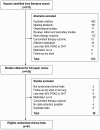Intraocular pressure-lowering effects of commonly used fixed-combination drugs with timolol: a systematic review and meta-analysis
- PMID: 23028770
- PMCID: PMC3441590
- DOI: 10.1371/journal.pone.0045079
Intraocular pressure-lowering effects of commonly used fixed-combination drugs with timolol: a systematic review and meta-analysis
Abstract
Background: The first goal of medical therapy in glaucoma is to reduce intraocular pressure (IOP), and the fixed-combination medications are needed to achieve sufficiently low target IOP. The aim of this systematic review and meta-analysis is to evaluate IOP-lowering effect of the commonly used fixed-combination drugs containing 0.5% timolol.
Methods: Pertinent publications were identified through systematic searches. Over 85% of the patients had to be diagnosed with primary open-angle glaucoma (POAG) or ocular hypertension (OHT). Forty-one randomized clinical trials were included in the meta-analysis. The main efficacy measures were the absolute and relative values of mean diurnal IOP reduction, and the highest and lowest IOP reductions on the diurnal IOP curve. The pooled 1- to 3-month IOP-lowering effects after a medicine-free washout period was calculated by performing meta-analysis using the random effects model, and relative treatment effects among different fixed combinations were assessed using a mixed-effects meta-regression model.
Results: The relative reductions for mean diurnal IOP were 34.9% for travoprost/timolol, 34.3% for bimatoprost/timolol, 33.9% for latanoprost/timolol, 32.7% for brinzolamide/timolol, 29.9% for dorzolamide/timolol, and 28.1% for brimonidine/timolol. For the highest IOP decrease, relative reductions ranged from 31.3% for dorzolamide/timolol to 35.5% for travoprost/timolol; for the lowest IOP decrease, those varied from 25.9% for dorzolamide/timolol to 33.1% for bimatoprost/timolol. Both latanoprost/timolol and travoprost/timolol were more effective in lowering mean diurnal IOP than brimonidine/timolol (WMD: 5.9 and 7.0) and dorzolamide/timolol (WMD: 3.8 and 3.3).
Conclusions: All six commonly used fixed-combination drugs containing timolol can effectively lower IOP in patients with POAG and OHT, and both latanoprost/timolol and travoprost/timolol might achieve better IOP-lowering effects among the six fixed-combination agents.
Conflict of interest statement
Figures
References
-
- The AGIS Investigators (2000) The Advanced Glaucoma Intervention Study (AGIS): 7. The relationship between control of intraocular pressure and visual field deterioration. Am J Ophthalmol 130: 429–40. - PubMed
-
- van der Valk R, Webers CA, Schouten JS, Zeegers MP, Hendrikse F, et al. (2005) Intraocular pressure-lowering effects of all commonly used glaucoma drugs: a meta-analysis of randomized clinical trials. Ophthalmology 112: 1177–85. - PubMed
-
- Lichter PR, Musch DC, Gillespie BW (2001) CIGTS Study Group (2001) Interim clinical outcomes in the Collaborative Initial Glaucoma Treatment Study comparing initial treatment randomized to medications or surgery. Ophthalmology 108: 1943–53. - PubMed
-
- Kass MA, Heuer DK, Higginbotham EJ, Johnson CA, Keltner JL, et al. (2002) The Ocular Hypertension Treatment Study: a randomized trial determines that topical ocular hypotensive medication delays or prevents the onset of primary open-angle glaucoma. Arch Ophthalmol 120: 701–13. - PubMed
Publication types
MeSH terms
Substances
LinkOut - more resources
Full Text Sources
Other Literature Sources
Medical


